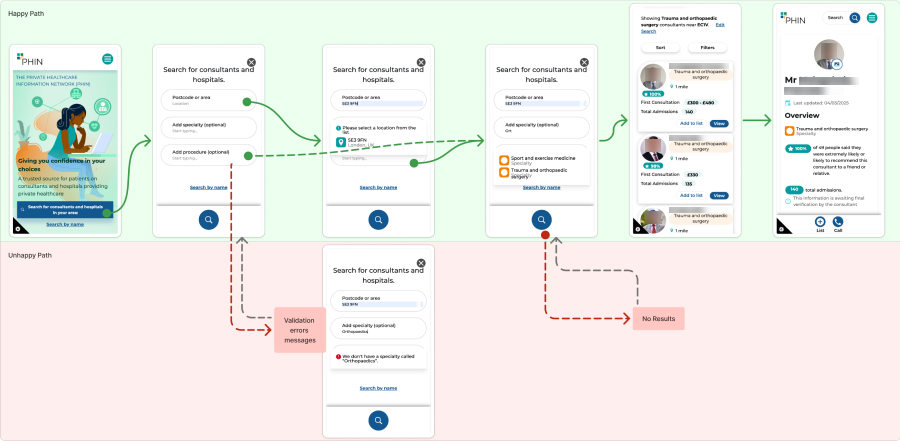Vibe Coding
Prototype: Searching for doctors on handheld devices
I document here a proposed autocomplete feature that categorises results without user intervention. Beyond traditional filters, this mobile-first solution simplifies patient journeys while maintaining ergonomic access and removes contrived barriers whenever possible.
UX Audit
While a strategy of incremental improvements is the norm, sometimes a system cannot be improved piece-meal, and an overhaul is needed. As an example, this is a mobile-first solution improving on a website search functionality.
 Analysis of the current search mechanics
Analysis of the current search mechanics
 Abridged wireframing of the proposed solution
Abridged wireframing of the proposed solution
I performed a brief market research revealing that competitors like Doctify and TopDoctors employed various search interaction patterns: Tabs, faceted navigation, and category-based filtering. The state of the art in search mechanics/dynamics warranted to move to a more "Don't Make Me Think" kind of approach.
Our research indicated that a non-trivial number of visitors used the website in what be considered a case of Emergency UX — or at the very least an understandable distress over the prospect of life-threatening illness. This was a strong rationale to eliminate all contrivances or barriers from finding the best possible healthcare practitioner.
Design choices for the Prototype:
- Optional Location input, leveraging IP-based geolocation by default, with the ability for users to refine it via postcode entry or map "pin drop" via Google Maps API.
- Post-hoc categorised search results, utilised by some competitors too. This would go instead of asking users with intermediate-to-nought medical knowledge to reason wether they were searching for speciality, procedure, location, etc. For example, typing "Car" would return visually separated, categorised results such as a speciality, "Cardiology,", a provider, "Cardiff Hospital," or a procedure, "Pericardial drainage".
- Ergonomic reachability, as searching constitutes the primary function of the website, I advocated for positioning the search bar prominently at the bottom for optimal ergonomic access on first tap, then on focus when on the top. There was an argument as to keep it always on the bottom but that would clash with Safari's search bar.
Additional features such as the following remained out of scope:
- Searching Providers (Doctors) by first and/or last name.
- NLP to handle misspelled specialities or procedures through "Did you mean..." suggestions.
